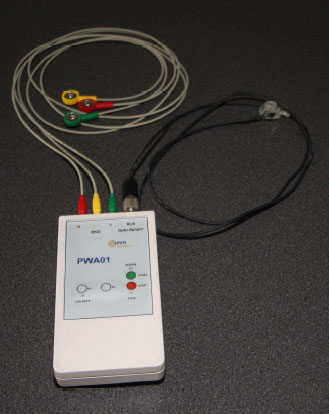
It has long been known that elevated intraocular pressure is an important risk factor for the development of glaucoma. But equally, unstable blood flow to the back of the eye is a pathological cause. About 40% of glaucoma patients with normal intraocular pressure show sensitivity to blood pressure fluctuations. Close observation of the cardiovascular system can provide insights that can improve diagnosis and therapy. For the investigation of vascular dysregulation, the CiS Research Institute for Microsensors and Photovoltaics, together with aviant GmbH from Jena, developed a multisensory solution that can record ECG and photoplethysmographic parameters synchronously in time.
If nerve or visual cells in the eye are not sufficiently supplied with blood, they can be damaged. This leads to degradation of the optic nerve and eventually to visual field loss. In patients with normal intraocular pressure, this is often due to a so-called vascular dysregulation. In this case, the vascular system is no longer able to adapt to the requirements of oxygen and nutrient supply to the eye to the necessary extent.
According to current knowledge, in normal pressure glaucoma patients not only the eye is diseased, but possibly the cardiovascular system of the body in general. Studies show that these patients suffer to an increased degree from circulatory disorders, e.g. in the hands or from heart disease.
The time-synchronous measurement of ECG and PPG should enable the screening of vascular dysregulation with a good sensitivity and, above all, a very high specificity.
By using modern low-power electronics and technologies of microsystems engineering, a solution was created that allows mobile monitoring of vital parameters over a period of hours.
The heart of the device, the PPG sensor for detecting the pulse wave, is characterized by high signal quality and excellent wearing comfort. Almost invisible, hidden in an earmold, the sensor is worn in the external auditory canal and can thus be used by the patient without restrictions, even in everyday life. This was made possible by the integration of a special optical emitter-receiver module manufactured using chip-in-chip technology. Established standard components were used for the ECG electrodes. The achieved resolution and sampling rate of ECG as well as plethysmogram are 24 bit, 200/100 Hz each.
A body-worn system electronics with dimensions of 100 mm x 40 mm x 20 mm, powered by two AA batteries, completes the mobile solution. In addition to the sensor control, this includes a data logger with low-noise and low-drift pre-amplification and signal processing. Data can be stored either on a conventional SD card or via a USB interface on the physician’s PC.
Visit us at COMPAMED 2013 in hall 8a, booth H23.1



